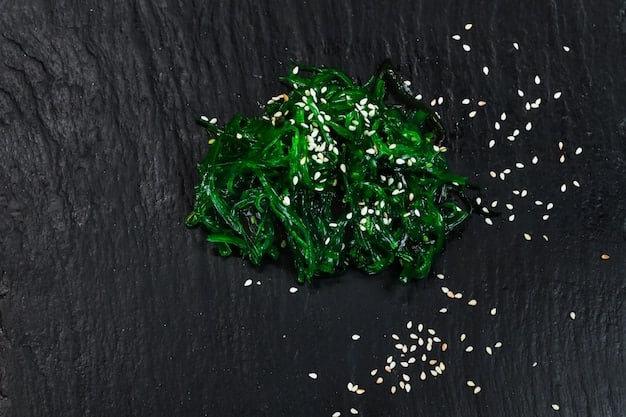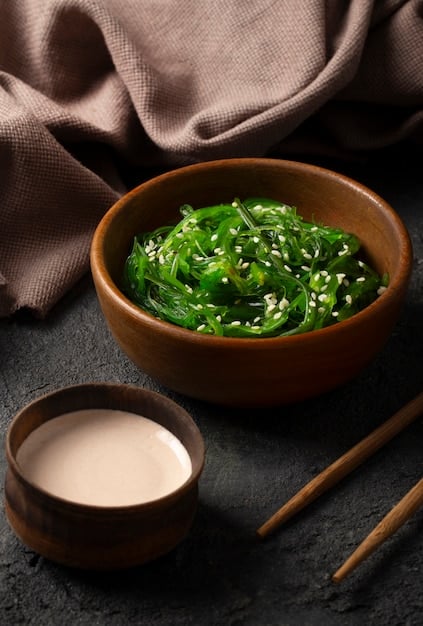Discover Nori to Wakame: Japanese Seaweed & Health Benefits

Nori and wakame, two popular types of Japanese seaweed, offer a wealth of health benefits, from boosting nutrient intake to potentially reducing the risk of chronic diseases, making them essential components of a balanced diet.
Embark on a flavorful journey into the world of Japanese seaweed! From the delicate sheets of nori to the silky strands of wakame, discover the unique tastes and incredible health benefits that these ocean treasures offer.
From Nori to Wakame: Understanding Japanese Seaweed
Japanese seaweed, integral to the nation’s cuisine, is more than just a culinary delight. It’s a powerhouse of nutrients, offering a unique umami flavor and a satisfying texture to a wide range of dishes. But beyond its culinary appeal, what exactly makes Japanese seaweed so special?
Let’s dive into the diverse world of Japanese seaweed, exploring its different types and understanding the characteristics that set each one apart.
The Essence of Nori
Nori, perhaps the most well-known type of Japanese seaweed, is celebrated for its versatility and distinctive flavor. But what defines nori, and how does it find its way into our favorite dishes?
- Cultivation and Processing: Nori begins its journey as a type of red algae cultivated in controlled environments. Through meticulous processing, the algae are shredded, pressed, and dried into thin, paper-like sheets, perfect for wrapping sushi or sprinkling over rice.
- Taste and Texture: Nori boasts a subtly smoky and slightly salty flavor, with a delicate, crisp texture that melts in your mouth. This unique combination makes it a perfect complement to a variety of flavors.
- Culinary Applications: From the iconic sushi rolls to onigiri rice balls and even as a flavorful seasoning, nori’s versatility shines through. Its ability to enhance both sweet and savory dishes makes it a staple in Japanese cuisine.

The Depths of Wakame
Wakame, another popular variety of Japanese seaweed, is known for its vibrant green color and silky texture. But what makes wakame different, and how does it enhance our culinary experiences?
- Origin and Habitat: Wakame thrives in the cool waters surrounding Japan and Korea. This brown algae is carefully harvested and then processed to preserve its unique characteristics.
- Flavor Profile: Wakame offers a mild, slightly sweet flavor with a distinctive oceanic aroma. Its smooth, silky texture adds a delightful contrast to other ingredients in salads, soups, and more.
- Versatile Usage: Wakame is a star ingredient in miso soup, seaweed salads, and various vegetable dishes. Its ability to absorb flavors and add a subtle depth makes it an indispensable component of Japanese gastronomy.
In essence, Japanese seaweed is not just a food; it’s a testament to the resourcefulness and culinary artistry of Japanese culture, transforming simple ingredients into delightful and nutritious experiences.
Nutritional Powerhouse: Health Benefits of Seaweed
Beyond its unique flavors and textures, Japanese seaweed is a nutritional powerhouse, offering a wealth of vitamins, minerals, and antioxidants. But what specific health benefits can you derive from incorporating seaweed into your diet?
Discover how nori, wakame, and other varieties of Japanese seaweed can contribute to your overall well-being.
Vitamins and Minerals in Abundance
Japanese seaweed stands out because of its exceptional concentration of essential vitamins and minerals. But which vitamins and minerals does it offer, and how do they benefit your health?
Seaweed is an excellent source of:
- Iodine: Crucial for thyroid function and hormone regulation.
- Iron: Essential for red blood cell production and oxygen transport.
- Calcium: Important for bone health, muscle function, and nerve transmission.
- Magnesium: Plays a vital role in energy production, muscle relaxation, and nerve function.
Antioxidant Properties
The antioxidant properties of Japanese seaweed are another vital element that enhances its health benefits. But how do these antioxidants work, and what advantages do they offer?
Seaweed contains powerful antioxidants, such as:
- Fucoidan: A unique compound found in brown seaweed that may have anti-inflammatory and anti-cancer properties.
- Phycocyanin: A blue pigment found in spirulina (a type of blue-green algae) that exhibits antioxidant and anti-inflammatory effects.
- Polyphenols: Plant compounds with antioxidant properties that protect cells from damage caused by free radicals.

Potential Health Benefits
The nutrient-rich composition of Japanese seaweed translates into a range of potential health benefits. But what specific advantages can you expect when incorporating seaweed into your diet?
Consuming seaweed may help with:
- Supporting Thyroid Health: The high iodine content promotes optimal thyroid function.
- Boosting Immune Function: Antioxidants and other nutrients contribute to a strengthened immune system.
- Promoting Heart Health: Certain compounds in seaweed may help lower blood pressure and cholesterol levels.
In conclusion, Japanese seaweed is more than just a flavorful ingredient; it’s a powerhouse of essential nutrients and antioxidants, making it a valuable addition to a balanced diet and a contributor to overall well-being.
Nori: The Versatile Sushi Staple
Nori, the dark green seaweed sheet that encircles sushi rolls, has transcended its traditional role to become a global culinary sensation. But what exactly makes nori so versatile, and how can you incorporate it into your daily meals?
Discover the art of nori and its diverse applications in your kitchen.
Sushi Rolls and Beyond
Nori’s primary role is undoubtedly in sushi rolls, where it acts as a pliable wrapper for rice and various fillings. But what makes nori such a perfect fit for this purpose, and what other culinary options does it offer?
Beyond sushi, nori is often used:
- Onigiri (Rice Balls): Nori adds flavor and texture to these popular Japanese snacks.
- Seasonings: Crumbled nori can be used as a flavorful topping for rice, noodles, and salads.
- Snacks: Roasted nori sheets are becoming increasingly popular as a healthy and convenient snack.
Choosing Quality Nori
The quality of nori can significantly impact the taste and texture of your dishes. But how do you discern the best nori sheets?
When selecting nori, look for:
- Color: Dark green or black sheets indicate high quality. Avoid sheets that are pale or have brown spots.
- Texture: The sheets should be smooth, glossy, and slightly brittle.
- Aroma: A fresh, slightly salty aroma is a sign of good quality.
Creative Nori Applications
Nori’s adaptability extends far beyond traditional Japanese cuisine. Its unique flavor and texture make it an ideal ingredient for a wide range of culinary experiments. But how can you creatively incorporate nori into your dishes?
Explore these creative uses in your kitchen:
- Nori Chips: Lightly toast nori sheets in the oven for a crispy and healthy snack.
- Nori Broth: Add nori to vegetable broth for an umami-rich flavor.
- Nori Pesto: Blend nori with nuts, garlic, and olive oil for a unique pesto.
In essence, nori is not just a sushi ingredient; it’s a versatile and nutritious food that can add flavor, texture, and a touch of Japanese flair to a wide range of dishes.
Wakame: Miso Soup and Seaweed Salad Sensation
Wakame, known for its delicate flavor and silky texture, is a staple ingredient in many Japanese dishes, most notably miso soup and seaweed salad. But what exactly makes wakame so special, and how can you incorporate it into your culinary repertoire?
Discover the art of wakame and its diverse applications in your kitchen.
Miso Soup Essential
Wakame is an indispensable component of miso soup, adding a subtle depth of flavor and a delightful texture. But what makes wakame such a perfect fit for this purpose, and how does it enhance the overall experience?
Wakame’s delicate flavor complements miso, creating a harmonious blend that is comforting and nutritious.
Seaweed Salad Delight
Wakame is also a star ingredient in seaweed salads, where its smooth, silky texture and mild flavor create a refreshing and satisfying dish. But what makes wakame such a great choice for seaweed salads, and what other ingredients complement it well?
Wakame absorbs flavors well, making it an ideal base for seaweed salads, which are often dressed with sesame oil, soy sauce, and rice vinegar.
Preparing Wakame
Wakame is typically sold dried and needs to be rehydrated before use. But how do you properly prepare wakame to retain its texture and flavor?
Here’s how to prepare wakame:
- Soaking: Soak dried wakame in cold water for 5-10 minutes until it expands and softens.
- Rinsing: Rinse the wakame thoroughly to remove any excess salt or sand.
- Cutting: Cut the wakame into bite-sized pieces before adding it to your dish.
In conclusion, wakame is not just a garnish for miso soup; it’s a versatile and nutritious ingredient that can add flavor, texture, and a touch of Japanese elegance to a variety of dishes.
Beyond Nori and Wakame: Other Japanese Seaweed Varieties
While nori and wakame are undoubtedly the most well-known types of Japanese seaweed, the world of sea vegetables extends far beyond these two varieties. But what other types of seaweed exist, and what unique flavors and textures do they offer?
Discover the less explored but equally fascinating varieties of Japanese seaweed.
Kombu: The Umami Enhancer
Kombu, a type of kelp, is prized for its umami-rich flavor, making it an essential ingredient in Japanese cuisine. But what exactly makes kombu so special, and how is it used in cooking?
Kombu is used to make dashi, a fundamental broth in Japanese cuisine. It’s also often simmered to create flavorful side dishes and additions to soups and stews.
Hijiki: The Earthy Delight
Hijiki, a type of brown seaweed, has a unique earthy flavor and a slightly chewy texture. But what are the characteristics of hijiki, and how can you incorporate it into your dishes?
Hijiki is often soaked and simmered with soy sauce, sugar, and other seasonings to create a flavorful side dish. Its robust flavor pairs well with vegetables and tofu.
Arame: The Mild and Versatile Option
Arame, a type of kelp, has a mild and slightly sweet flavor, making it a versatile ingredient for a variety of dishes. But what are the defining characteristics of arame, and how can you use it in your kitchen?
Arame can be soaked and added to salads, stir-fries, and soups. Its mild flavor makes it a great option for those new to seaweed.
In conclusion, while nori and wakame may be the stars, other Japanese seaweed varieties like kombu, hijiki, and arame offer unique flavors, textures, and culinary possibilities, expanding the horizons of Japanese cuisine.
Incorporating Seaweed into Your Diet: Tips and Recipes
Now that you’ve explored the diverse world of Japanese seaweed and its many health benefits, you may be wondering how to incorporate it into your everyday diet. But what are some easy and delicious ways to enjoy the flavors and advantages of seaweed?
Discover practical tips, creative ideas, and simple recipes to make seaweed a regular part of your culinary routine.
Easy Snacking
One of the simplest ways to enjoy Japanese seaweed is as a snack. But what are some convenient and enjoyable snack options that incorporate seaweed?
Try these easy and accessible snack options:
- Roasted Nori Sheets: These crispy and savory sheets are a healthy and portable snack.
- Seaweed Crackers: These can be found at most grocery stores. They give a satisfying crunch and a dose of umami.
- Seaweed Popcorn: Sprinkle crumbled nori over freshly popped popcorn for a flavorful and healthy treat.
Simple Recipes
Seaweed can be easily incorporated into a variety of simple recipes. But what are some quick and easy dishes that highlight the flavors and nutritional benefits of seaweed?
Consider these easy recipes that highlight seaweed:
- Seaweed Salad: Quick homemade salad that is healthy and tasty.
- Miso Soup: A comforting and nutritious soup that utilizes wakame.
- Seaweed Rice Bowls: Add crumbled nori and other toppings to a bowl of rice for a quick and satisfying meal.
Creative Culinary Ideas
For those who enjoy experimenting in the kitchen, seaweed offers a world of creative possibilities. But what are some innovative ways to incorporate seaweed into your cooking?
Consider these experimental ideas that highlight seaweed:
- Seaweed Smoothies: Add a small amount of spirulina or other seaweed powder to your smoothies for a boost of nutrients.
- Seaweed Butter: Blend softened butter with crumbled nori for a flavorful and savory spread.
- Seaweed Pasta: Add wakame to pasta dishes for extra flavor and texture.
In conclusion, incorporating Japanese seaweed into your diet is easy, delicious, and rewarding. With a little creativity, you can enjoy the unique flavors and health benefits of these ocean treasures in a variety of ways.
| Key Point | Brief Description |
|---|---|
| 🌱 Nutritional Benefits | Rich in iodine, iron, calcium, and magnesium. |
| 🍣 Nori Uses | Ideal for sushi, onigiri, and as a snack. |
| 🍜 Wakame in Cuisine | Commonly used in miso soup and seaweed salads. |
| 🌿 Other Varieties | Kombu, hijiki, and arame offer unique flavors and uses. |
Frequently Asked Questions
▼
The main types include nori, wakame, kombu, hijiki, and arame, each offering unique flavors and textures, and used in diverse culinary applications from sushi to soups.
▼
Nori is extremely versatile. It can be used for making sushi, wrapping onigiri, as a flavorful topping on rice bowls, or enjoyed as a crispy and healthy snack on its own.
▼
Wakame is rich in essential nutrients like iodine, iron, and calcium. It supports thyroid health, boosts the immune system, and may promote heart health.
▼
To prepare dried wakame, soak it in cold water for 5-10 minutes until it expands and softens. Rinse it thoroughly to remove any sand, then cut it into bite-sized pieces before adding to your dish.
▼
Kombu is a type of kelp known for its umami flavor, and is often used to make dashi, a fundamental broth in Japanese cuisine. It’s also simmered as a side dish.
Conclusion
From the delicate embrace of nori in sushi to the silky strands of wakame enhancing miso soup, Japanese seaweed offers more than just unique flavors and textures. It provides us with a nutritional treasure trove, contributing to our overall well-being and enriching our culinary experiences. So, whether you’re a seasoned sushi aficionado or a curious foodie, take a plunge into this oceanic bounty and discover the delights of Japanese seaweed.





